Novalys 2005 Worldwide Survey Results
In 2005, we have conducted again a survey on the use of PowerBuilder.
More than to 3000 people of all nationalities have participated!
You'll find here the first results to the following questions:
- How long do companies intend to use PowerBuilder?
- What are the new tools frequently used?
- What development tools are/will be used at the same time as PB
?
- To what extend will PowerBuilder be used for web development?
- ... and lots more!
To receive regular information on
PowerBuilder by email,
simply subscribe our free PowerBuilder Newsletter!
- How long will PowerBuilder be used in your company?
- In 2005, will you mainly use PowerBuilder to maintain or develop your applications?
- How many developers will use PowerBuilder in your company in 2005? (aproximately)
- Which PowerBuilder version do you currently use?
- In 2005, do you plan to migrate to a more recent PowerBuilder version?
- Does your application include stored procedures?
- Do you use PowerBuilder to develop your Web Applications?
- Do you use PocketBuilder to develop Mobile Applications?
- Do you use DW.Net to develop .Net Applications?
- Which other technologies are (or will be) used in your company?
- Which improvements are you waiting for the most?
- What is your opinion about PowerBuilder?
- Respondents comments
- Countries of origin
1) How long will PowerBuilder be used in your company?
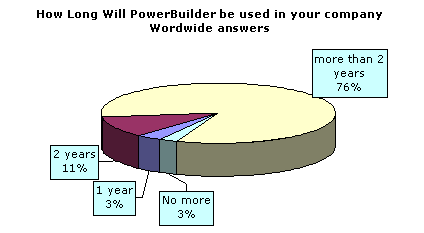

Few users say they have stopped using PowerBuilder...
then of course those who answer our questions are those who
use it!
Nevertheless, these current PowerBuilder users plan on using
it for quite a few more years: 76% declare they will be using
it for more than the next two years.
2) In 2005, will you mainly use PowerBuilder to maintain or develop your applications?
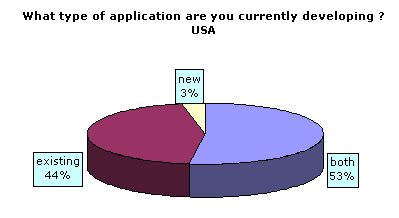
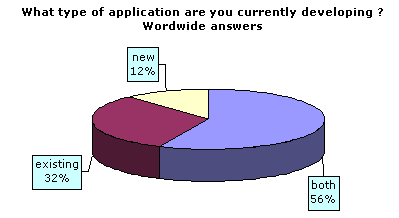


There is an interesting change regarding new applications
developed in PowerBuilder.
In 2003 6 % of the participants said they were only working
on new applications (None in 2002).
After a strong increase last year (an additional 5 points
in 2004) the trend seems to stabilise in 2005, 12% work solely
on new PowerBuilder projects.
The difference between the USA and the rest of the world is
stronger in 2005; as we said 12% in the world have been only
developing in PowerBuilder compared to only 3% in the USA
(There was 4 points difference in 2004 between these two results)
3) How many developers will use PowerBuilder in your company in 2005?
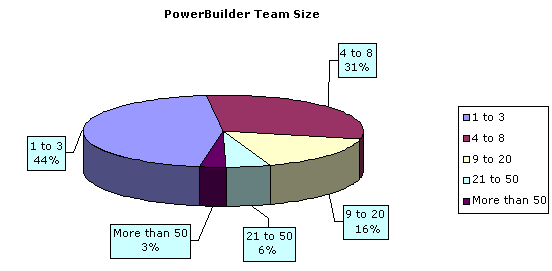
The number of small teams (1 to 3 developers)
has increased; from 38% in 2004 to 44% in 2005. PB is still
nevertheless also used by large teams (State agencies or private
companies): 47% of the teams recruit 4 to 20 developers.
4) Which PB version do you currently use?
5) In 2005, do you plan to migrate to a more recent PowerBuilder version?
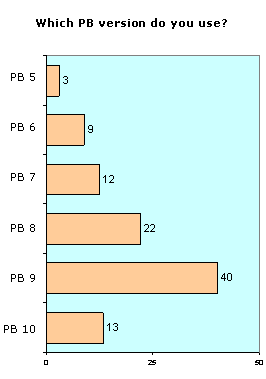
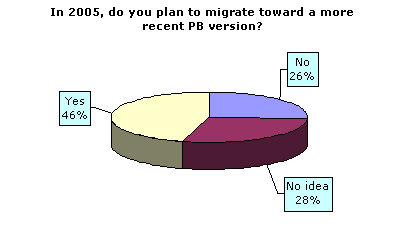
PowerBuilder 9 is used by 40% of the respondents
while 22 % still work with PB8
and 24 % with previous versions which are not supported by
Sybase anymore.
The number of developers using PB10 has already increased
from 1% en 2004 to 13% this year.
Finally, nearly half of the participants plan to migrate to
a more recent version of PB.

6) Does your application include stored procedures?
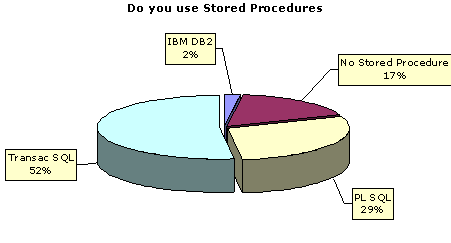
Most PowerBuilder projects used Stored Procedures (83%).
Unsurprisingly most of them 52% use Sybase's language: Transac
SQL.
Still PL SQL is used for 29% of the PB applications.
7) Do you use PB to develop your Web Applications?


The use of PowerBuilder for Web development
was quite stable for 2 years; today there is a slight decline:
15% of the users use PowerBuilder to develop their web application
(18% in 2004).
On the contrary the number of people who intend to develop
all or part of their web application with PowerBuilder in
the future has increased from 50 to 55% since last year’s
results.
8) Do you use PocketBuilder to develop Mobile Applications?
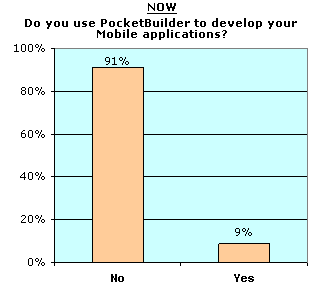

9% of the participants use PocketBuilder
to develop their mobiles applications.
41% of them plan in using it in the future.
9) Do you use DW.Net to develop .Net Applications?
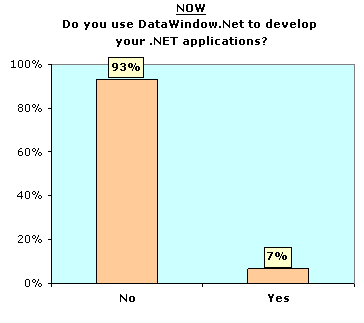

7% of the participants use DW.Net for the
development of their .NET applications.
46% of theses respondents plan on using it in the future.
10) Which other technologies are (or will be) used in your company?

54% answered Microsoft which is close to the 2004 results.
Java gains 2 points from the 2004 answers and is the leading
answer with Microsoft in our survey this year with 54%.
On the whole companies confirm they will be using different
tools simultaneously.
11) Which improvements are you waiting for the most?
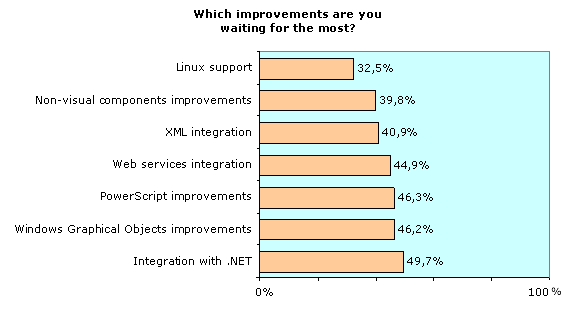
A massive majority of developers answers
this question.
Among the improvements mentioned the most expected one is
a better integration to .NET (50%) closely followed by the
wish for Windows Graphical Objects improvements and those
of PowerScript (46%). It is interesting to learn about the
remaining answers as they represent 33%.
12) What is your opinion about PowerBuilder?
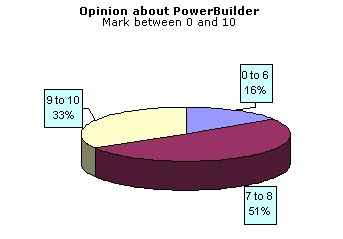
Although there is a slight decrease in the
rate of satisfaction, in average, PowerBuilder was marked
is 8/10.
- 33 % are very satisfied (9/10 & 10/10), compared to
39% in 2004 but only 23% in 2003 and 18% in 2002.
- 16% are not satisfied (marks between 0/10 and 6/10) when
it was 12% in 2004, 18% in 2003 and 17% in 2002.
13) Comments
More than 900 participants added comments.Click here to review them...Top
